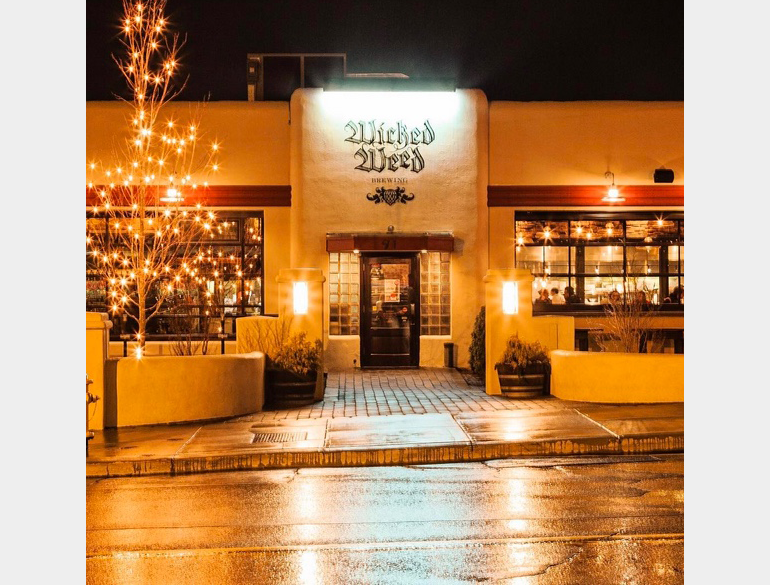Start 14-Day Trial Subscription
*No credit card required

Wicked Weed's Divisive Deed (Issue 31)
I was always slightly amazed once marijuana for personal use became legal in Colorado that a certain beer from North Carolina whose name implied cannabis still sustained one of the longest lines each year at the Great American Beer Festival in Denver. A nod-and-a-wink excitement about the name surely couldn’t have been the draw. It must have been the beer far more than the brand Wicked Weed that attracted such patience and relatively long lines – although perhaps it paired well with the newly legalized greenery.
It will be interesting to see if the popularity of this Asheville, N.C. brewery continues this year, given its recent sale to AB InBev and the more cacophonous fallout than usual when a beloved craft brewer crosses over to what many in the GABF community view as the dark side. Beyond the swearing off and declarations that this beer brand would never be purchased again by those who are dedicated to craft, there was more than the usual castigation of the ownership for taking the money and the greater distribution that comes with being a member of the world’s largest brewing operation.
If Portland, Ore., is Beervana, the city of Asheville is Beer Paradise. The town’s longstanding charm as a mountainous retreat for those seeking alternate lifestyles and the allure of nature became a perfect fit for craft beer culture. In just five years, Wicked Weed became its best- known destination and export. And then it was gone or, more accurately, it crossed over. Perhaps Asheville’s bohemian aura combined with the recent arrival of major craft expansions by New Belgium and Sierra Nevada led to a naïve belief this beloved place was beyond the allure of cash – an estimated $150 million.
For those following this ongoing battle between major brewers and independent craft brewers, the buyout of Wicked Weed appears to be a tipping point. But I predict the ongoing dialectic between bigger brewers and independent brewers will continue in a manner that produces better beer. The bigger brewers are now establishing a path away from their traditional premium lagers towards the styles championed by craft lovers. Craft will remain the resistance fighters with weapons that money can’t buy: creativity.
The next phase is familiar in the case of Wicked Weed. To recoup the investment, a craft brand purchased by one of the macro brewers has its output increased along with wider distribution, which helps eat up more shelf space in significant outlets and further muddy the issue among the general populace of which breweries are independent.
But wait, there’s more bad news if you’re on the side of craft. According to investment bankers who help make such deals happen, for every customer that opts out of purchasing an acquired brand, the company brings in two new customers. Whether that’s typical palaver of financial types, there’s probably some accuracy to it. In other words, protest and resistance have their limits. The key thing to remember is that this expansion generally results in a reduction of pricing.
To me, there’s always been the vague notion among craft geeks that in order to change the world craft brewers have to somehow defeat so-called Big Beer. It’s only fun if there’s some sort of takedown involved along with the joy of watching those who created industrial beer steadily lose market share. The underbelly of that fantasy is a corresponding fear – the empire might strike back and drive craft into exile.
For those dedicated to independent craft breweries, it’s a fight worth fighting, even if the big guys continue to pick off breweries as the seasons come and go. (The other worldwide brewing types are just as clever as AB InBev, and perhaps more so in that they let the Belgian-based behemoth take the heat for the assault on craft while waging their own deals.)
The key point of outrage for those committed to craft: a sale of this nature makes it harder for those in the beer-making community left behind to continue the fight for what they hold sacred.
The ecosystem of a worldwide corporation and its influences are vastly different than smaller, independent financial entities created by those focused on the communities in which they live. Craft brewers dedicate themselves to a community’s well-being through such undertakings as charitable events, support for environmentally beneficial practices, support for local growers and as places where people of different persuasions can enjoy conversations in an increasingly uncivil society. The fact it’s all driven by broadening the adventure of imbibing by creating new taste horizons in beer is, well, just plain cool.
This wouldn’t have happened unless major brewers had tried, let’s be honest, to cheat consumers by eliminating competition and replacing it with a land awash in industrial beer in the name of money and power. The good news: this is what created the American craft movement.
For craft lovers, what can be done beyond continuing to support craft and not getting overly caught up in the illusion that not buying a certain brand will somehow topple big beer?
Call me crazy but I don’t think the answer is complicated. Craft brewers need to make beer that its followers are willing to buy at relatively higher prices such as hop-laden IPAs in various styles, incredibly powerful stouts and extraordinary sours. In other words, keep making beer so damned good that beer lovers will pay more for it.
As recently outlined by Chris Herron, the CEO at Creature Comforts Brewing Company in Athens, Ga., the big brewers need to keep raising expectations and profits for its premium lagers by raising its price and lowering those of its own craft offerings. It’s a bit of retail hocus pocus designed to persuade the average consumer. If you don’t think it’s working consider that AB InBev continues to be profitable in the U.S. despite declines in consumption of its premium lagers. If you don’t think that’s the strategy, check the pricing on Goose Island IPA or the beers sold by Breckenridge, among other acquisitions.
Given the rise in the percentage of retail sales of six-packs in the $12 to $15 range in the past two years, craft is already headed in the upward direction. Aspirational pricing is working well beyond the $15 per six-pack range, too. Craft doesn’t need to be swimming in shelf whales to win the battle; quite the contrary. Just sustain what’s already worked well. Keep making – and buying – better beer today with more and better ingredients than what was out there yesterday. And accept that it has to be priced accordingly.
This could make takeover targets out of even more craft breweries. But the craft community continues to be awash in talent, business smarts and options for financing that will continue to propagate more new, larger and innovative breweries – especially if the return on investment is, well, stout. It’s been happening in places like Northern California, Texas, Massachusetts and Georgia simultaneously to the outbreak of acquisitions. Call me crazy, but I think for every craft brewery that gets bought out – and therefore brings more craft-style beer to the market – there’s at least three, four or more independent start-ups that can make and sell beer as good if not better.
(Editor’s note: Jonathan Ingram currently works for the Scofflaw Brewing Company as The Media Relations Guy. A former editor of The Beer Connoisseur, he continues to occasionally contribute stories on beer to various websites and magazines.)



